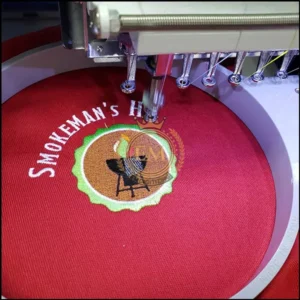Digitizing logos for embroidery has become an essential process in the world of textile decoration. With advancements in technology, the traditional manual method of replicating logos through embroidery has been replaced by digitization.

EMdigitizing is the go-to company for all your embroidery logo digitization needs. We have a team of skilled embroidery logo digitizers who work together to ensure you receive high-quality results at an affordable price. Get in touch with us today.
This article will explore the benefits of digitization for embroidery. By understanding the advantages of digitizing logos, businesses, and individuals can achieve the best embroidery results while keeping up with the demands of the modern market.
Digitizing Logos Benefits For Optimal Embroidery Results
Benefits of Digitizing Logos for Embroidery
Let’s talk about the benefits of logo digitizing:
1. Precision in Logo Digitization
Digitizing logos ensures that you get a crisp and detailed logo design. From the smallest text to the finest lines, the digitization process ensures that your logo is translated onto fabric with utmost precision. No more blurry or distorted images – your logo will be clear and sharp.
2. Accurate Color Representation
Colors play a vital role in branding, and you want your logo to be represented accurately. With digitization, the colors in your logo are matched precisely, ensuring that the embroidered version stays true to the original design.

Say goodbye to mismatched hues or faded shades of your brand colors.
3. Quality Logo Stitching
Digitizing logos is a crucial step towards achieving high-quality embroidery results. It sets the foundation for flawless execution and detailed reproduction of your logo.
By investing in the digitization process, you can ensure that the final embroidered product meets your expectations in terms of quality, precision, and visual impact.
4. Eliminating Stitching Distortions
One of the biggest challenges in embroidery is achieving smooth and even stitching. Digitizing logos helps eliminate stitching distortions by providing precise instructions to the machine.

This means that even complex designs can be faithfully reproduced, without any wonky lines or uneven stitches. Your logo will look flawless every time.
5. Reduced Production Time
Digitizing logos speeds up the production process by allowing embroidery machines to work efficiently.
With the digital file guiding the machine, there’s no need for manual adjustments and guesswork. This means faster turnaround times, especially for large orders or intricate designs.
6. Simplified Logo Reproduction
If you need to replicate your logo on different items or garments, digitizing logos makes the process a breeze.

Once the digital file is created, it can be easily adjusted to fit various sizes and embroidered onto different materials. This versatility saves time and effort, allowing you to showcase your logo on a variety of items effortlessly.
7. Logo Resizing and Scaling
One of the biggest advantages of digitizing logos for embroidery is the ability to resize and scale them without losing any detail or quality.
Whether you need a tiny logo for a hat or a larger one for a jacket, digitization ensures that your logo doesn’t lose its clarity or sharpness.
8. Decreased Labor Costs
By digitizing logos, you can also cut down on labor costs. Traditional embroidery methods often require skilled artisans to painstakingly trace the design by hand.
Digitization simplifies this process, reducing the need for skilled labor. This means you can allocate your resources more efficiently and potentially reduce costs, allowing you to offer competitive pricing to your customers.
9. Consistency in Logo Replication
Consistency is key when it comes to branding. Digitizing logos ensures that every embroidery reproduction of your logo is consistent in size, shape, and placement.
No more worrying about variations between different pieces or batches. Your logo will look uniform across all your embroidered items, maintaining a cohesive brand identity.
10. Precise Stitching Placement
Digitized logos allow for precise and expert stitching placement. Every stitch is meticulously planned and executed, resulting in a logo that pops and catches the eye.

Say goodbye to misaligned or uneven embroidery. With digitization, your logo will be flawlessly stitched, creating a polished and professional finish that elevates your brand to new heights.
Conclusion: Enhancing Embroidery with Digitized Logos
Digitizing logos can have a big impact on businesses of all sizes. It can also help improve embroidery results. If you want your logo digitizing services, we can help you out!
We offer embroidery digitizing and vector art services that can enhance your business reputation in today’s ever-evolving market.
If you’re a first-time client, we have a special offer just for you! You can get 50% off on all our services and expect the best results. We also provide a free quote, which only takes 5 minutes to generate.
So why wait? Get in touch with us today!
If you found this article helpful, don’t forget to share it with your friends. We also encourage you to share your thoughts with us. We’d love to hear what you think about this topic!
Thanks for reading!
Frequently Asked Questions:
Embroidery digitizing transforms artwork into a digital file that embroidery machines can read, enabling intricate and precise designs on fabric. This process enhances design quality, allows for mass production, and provides flexibility in modifying designs.
Digitizing a logo for embroidery involves converting a logo design into a stitch file that an embroidery machine can interpret. This process ensures that the logo can be accurately and efficiently embroidered onto various materials.
Having a logo digitized means converting the logo into a format suitable for embroidery, allowing for consistent and high-quality reproduction of the logo on garments and other textiles.
The function of a digitizing machine is to read digital embroidery files and use them to guide the embroidery process, ensuring precise stitch placement and pattern replication on the fabric.
The benefits of digitization include increased efficiency, improved accessibility of information, enhanced data analysis capabilities, and the preservation of documents and records in a durable, digital format.
Digitization refers to the process of converting information into a digital format. Its benefits include easier sharing and storage of data, quicker data processing, and the ability to automate and integrate various processes.
